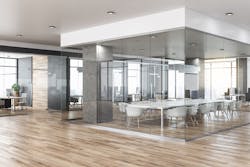Proper Lighting and Control Strategies Offer Multiple Benefits in a Variety of Commercial Interior Environments
Prior to the invention of the lightbulb, buildings were lit primarily by the sun during the day, which limited the distance daylight could penetrate the space through windows. Once electric lighting, improved building materials and mechanical ventilation were introduced, larger designs emerged that pushed occupants further into the building and away from the outdoors, which resulted in negative health impacts, according to the American Institute of Architects (AIA).
“Those without access to daylight and views have been shown to be less productive and less creative, and to take more sick days—at a significant expense to their communities and the companies for which they work,” the AIA reported in its Framework for Design Excellence series.
Today, views to the outdoors and other daylighting strategies in buildings are becoming commonplace, especially as more companies focus on the health and wellness of their employees and visitors. In existing facilities where ample daylight and views to nature are somewhat limited, retrofits to improve daylighting can be costly.
Fortunately, by implementing the right lighting and control strategies, design professionals and facility executives can reap the benefits of proper lighting in any type of building they’re working with.
Daylighting vs. Daylight Harvesting: What’s the Difference?
Aren’t daylighting and daylight harvesting the same thing? Not exactly.
Daylighting is a term that describes building apertures, along with their associated management components, for the controlled admission and distribution of daylight. Electric lighting and controls are utilized to supplement daylight to support the desired function of the space throughout the day.
Daylighting requires architectural design elements to strategically incorporate natural light into the structure’s aesthetics and functionality. This is a process that typically happens during the pre-construction and construction phase of a new project and is required by codes and standards including IECC, ASHRAE 90.1 and 2019 Title 24, Part 6.
On the other hand, Daylight Harvesting is the technique employed by lighting controls to manage the artificial light and meet task requirements in each space. Sensors are used to collect information about the environment and fine tune the lighting to meet the needs of the occupants.
Common harvesting methods include dimming or switching lights when enough ambient light is present or installing occupancy sensors that keep lights off in rooms that are vacant and turning them on when occupants enter the space.
In most applications, daylight harvesting can result in a 35-60% energy reduction in buildings, saving money and resources. It also helps to create a more pleasant, properly illuminated space. As noted earlier, while existing buildings can be remodeled to incorporate more daylighting, these renovations can be costly.
Daylighting zones can also be created within a building that stagger the dimming and switching of lighting loads depending on a zone’s distance from ambient light sources, such as windows or skylights, which requires integrated photocells to sense lighting in each zone. Daylight harvesting can also be achieved through advanced scheduling based on time-of-day and sunrise/sunset clocks to ensure exterior lighting is not on during daylight hours (also known as Time Clock Control).
The Importance of Color Tuning in Interiors
When it comes to creating an optimal visual environment, color tuning plays a vital role in the process. Color tuning is the adjustment of the light source spectrum in response to task, space, or occupant needs.
[Related: Color Theory Helps Explain Our Relationship to Nature and Wellbeing]
Utilizing proper color tuning techniques with the right controls offers a variety of benefits to facilities and occupants, including improved employee productivity and morale; superior ambiance and increased guest satisfaction; improved occupant well-being; optimal display of products in retail settings, leading to increased sales; and better learning environments and attendance in education applications. Here’s how:
- Healthcare. Hospitals and doctors’ offices can increase stress levels in adults and children alike. Designers can help combat this by utilizing color tuning and controls to nurture a welcoming, home-like atmosphere to put patients at ease and make all visitors comfortable. Proper light levels and colors can also render skin tones more accurately to help medical staff visually identify illnesses such as jaundice, rashes, infections, fevers and other conditions. Bringing natural coloring of the sunrise/sunset light cycle to the space can further enhance the healing process, increase wakefulness throughout the day and promote better sleep at night.
The health benefits of lighting aren't limited to color, however. UV lighting technology is currently being deployed in healthcare environments and other occupied high-traffic spaces to support sanitation and disinfection protocols. In fact, UV light has shown significant reductions in common pathogens associated with hospital-acquired infections (HAIs), such as MRSA and Staphylococcus aureus.
- Offices. Replicate natural colors throughout the workday in both spaces that receive natural lighting and those that are fully enclosed. This is significant because it can help keep occupants aligned with their natural circadian rhythms, which has been shown to improve employee productivity and morale. Individual customization for private offices, conference rooms and other specialty areas can be achieved as well.
- Education. Studies have shown that the right lighting has a positive impact on student focus, attendance and performance. Create better learning environments with LED lighting that provides pleasant, natural illumination. Classrooms, study rooms, dorm rooms and other specialty spaces can be individually customized for optimal levels.
- Hospitality. First impressions make a big impact on guests, so designers need to create inviting and appealing spaces. One way to do that is to precisely design indoor lighting to match furnishing colors and materials, which can easily be adjusted later for furniture changes and building updates. Enhance lobbies and other atrium spaces with color tuning to provide higher color temperatures during the day, to make the space feel more vibrant, and warmer color temperatures in the morning to drive gentle wakefulness and the evening to make it feel cozy. Restaurant spaces can also take advantage of creating the optimal mood and ambiance at different times of the day for customers.
- Retail. Retailers want to showcase products in the best possible light. The optimal display and rendering of products—clothing and accessories appear more vibrant, truer and ultimately more appealing—can lead to increased sales. Further, retailers can utilize customization to reflect current product lines, seasons, merchandising schemes and more in display areas for dynamic and precisely designed stores that can be replicated across infinite numbers of locations for consistency.
- Gallery. The brilliant use of colors is clearly on display in art galleries and museums, where proper lighting is vital to appreciating works of art. As such, the right lighting and controls can help designers and museum staff modify lighting to highlight rotating collections to bring the truest sense of the art out for patrons to enjoy. It can also help protect irreplaceable works of art and investments by eliminating harsh lighting and UV rays from the space. They can also incorporate creative architectural lighting and customized scenes to make lighting another layer of art within the space.
Color Tuning Techniques
As demonstrated in the previous section, the ability to tune light fixtures to desired temperatures and intensities with the right controls has numerous benefits in a variety of applications, including:Dim to Warm—Warm Dimming refers to LED products that dim following the traditional gradual shift of incandescent light. As the current is reduced to the luminaire, the color of light shifts from cooler to warmer.
Tunable White—Tunable White is the ability to control the color of white light from a luminaire. This capability allows users to select the desired white color temperature appropriate for a specific function or user experience.
Color Tuning—Color Tuning is the ability of a luminaire to produce any color, from different colors of white to solid primary colors of red, blue, green or any color in between.
Human Centric Color—The ability of a luminaire to produce variable color temperatures throughout a day to replicate the color shift provided in nature. This color shift supports the natural circadian rhythm resulting in positive mental and physical heath benefits for people.
When it comes to implementing effective lighting design strategies and the incredible flexibility and many benefits of color tunable LED lighting systems, the question isn’t should you consider them—it’s why wouldn’t you?
This content was produced in partnership with Leviton. For more information, visitAbout the Author

Partner Content
Partner Content is submitted by our advertisers and does not represent the views of i+s or its publisher, Endeavor Business Media. Content may be edited for clarity and style.
